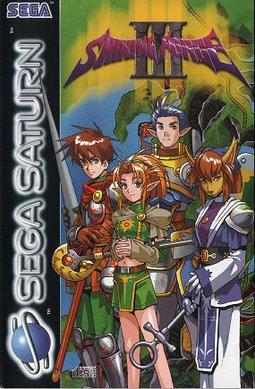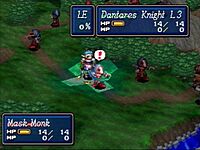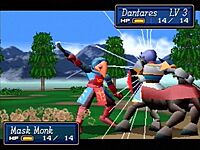Shining Force III facts for kids
Quick facts for kids Shining Force III |
|
|---|---|
 |
|
| Developer(s) | Sonic! Software Planning Camelot Software Planning |
| Publisher(s) | Sega |
| Director(s) | Yasuhiro Taguchi |
| Producer(s) | Hiroyuki Takahashi |
| Designer(s) | Hiroyuki Takahashi Shugo Takahashi |
| Writer(s) | Hiroyuki Takahashi |
| Composer(s) | Motoi Sakuraba |
| Series | Shining |
| Platform(s) | Saturn |
| Release date(s) | Scenario 1
|
| Genre(s) | Tactical role-playing game |
| Mode(s) | Single player |
Shining Force III is a tactical role-playing game for the Sega Saturn console. In Japan, the game was so big that it was sold in three separate parts, called Scenarios. Each part told the same story but from a different character's point of view.
Players could save their game data from one scenario and use it in the next. This was called the "Synchronicity system." It meant that choices you made in one game could change things in the next one.
However, in North America and Europe, only the first part, Scenario 1, was released. It was just called Shining Force III. This was the last game in the Shining series made by the original creators, Camelot Software Planning. The game was liked by critics but didn't sell many copies because it came out late in the Sega Saturn's life.
Contents
Gameplay
Shining Force III is a turn-based tactical RPG. This means you and the computer take turns moving your characters and fighting.
How Battles Work
Battles happen on a map made of squares, like a chessboard. Each character, or unit, takes up one square. On your turn, you can move a character a certain number of squares. After moving, you can perform an action like attacking an enemy, casting a magic spell, or using an item. The character with the highest agility stat usually gets to go first.
Just like in other RPGs, your characters get stronger by battling enemies. Winning fights gives them experience points (XP). When a character gets enough XP, they "level up," becoming more powerful.
Character Classes and Promotion
Every character has a class, like a knight or a mage. The class decides what weapons, armor, and spells they can use. When a character reaches level 10, you can choose to "promote" them to a new, more powerful class.
Winning and Losing
To win a battle, you usually have to defeat all the enemies or their leader. Sometimes you just need to move your leader to a specific spot on the map.
You lose if the enemy defeats your team's leader. But don't worry, there's no "game over." You can try the battle again, and your characters keep all the experience points they earned. This means your team gets stronger even if you lose. However, you do lose half of your money if your leader is defeated.
Friendship and Exploration
When characters fight alongside each other, they can become friends. If friends are close to each other in battle, they get a stat boost.
Outside of battle, you can explore towns and other areas. You control the leader of your army and can talk to people, find treasure, and buy new gear for your team. You also get to choose which characters will join you in the next fight.
Story of the Three Scenarios
The story of Shining Force III is told across three games, each showing the events from a different hero's perspective.
Scenario 1: Synbios's Story
This story follows Synbios, a young noble from the Republic of Aspinia. Aspinia used to be part of the powerful Empire of Destonia but fought for its independence. Now, the two nations are trying to make peace.
Synbios is sent to a peace meeting, but a mysterious religious group called the "Bulzome Sect" tricks the two nations into going to war again. Synbios and his army must fight the Empire while also trying to uncover the truth about the Bulzome Sect. Along the way, he meets Medion, a prince from the Empire, and they realize they must work together to stop the real enemy.
Scenario 2: Medion's Story
This part of the game follows Medion, the youngest prince of the Empire of Destonia. He is loyal to his father, the Emperor, but he suspects that someone else is causing the war with Aspinia.
Medion works behind the scenes to fight the Bulzome Sect and other traitors inside both the Empire and the Republic. He often helps Synbios's army without them knowing it. By working in parallel, Medion and Synbios try to expose the true villains who want to see both nations destroyed.
Scenario 3: Julian's Story
The final scenario follows Julian, a mercenary who is the true main hero of the game. At first, Julian is hunting a powerful being named Galm, who he believes killed his father.
Julian's quest leads him to join both Synbios's and Medion's armies at different times. He learns that the Bulzome Sect is trying to awaken an ancient evil Vandal named Bulzome. Julian's main goal becomes protecting a special child named Gracia, who is destined to stop Bulzome. In the end, Julian unites the armies of Synbios and Medion to face Bulzome in a final, epic battle.
Development and Release
Work on Shining Force III took almost two years. The game was made to be a huge adventure split into three parts. Each part was a full game that showed the story from a new angle.
In Japan, all three scenarios were released separately. But because the Sega Saturn was not selling well in other parts of the world, only Scenario 1 was released in English. The story in the English version was changed slightly to give it a more complete ending, since players would not be able to play the other two parts.
For Japanese players who bought all three games, Sega released a special Shining Force III Premium Disk. This disc had bonus content like artwork and extra battles.
There were talks about bringing Shining Force III to the PlayStation, but this never happened. Because Scenario 2 and Scenario 3 were never officially released in English, fans later created their own fan translations so that more people could enjoy the full story.



